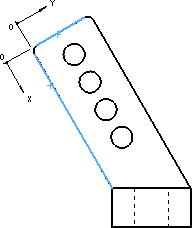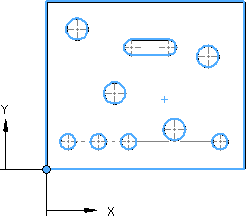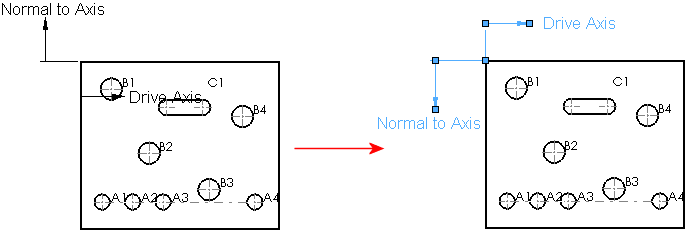Hole Tables
You can use hole tables to automatically
generate hole information in a tabular format. You can create columns
for model information, such as hole size and location.
Hole tables in drawing documents measure the positions of selected holes
from a specified origin datum. The software labels each hole with a tag
that corresponds to a row in the table.
 Non-circular holes such as rectangles and
slots are recognized as holes. The table lists the X and Y coordinates
of the entities by their geometric centers, but you must enter the size.
Non-circular holes such as rectangles and
slots are recognized as holes. The table lists the X and Y coordinates
of the entities by their geometric centers, but you must enter the size.
Holes that intersect other faces are not included in hole tables because
the geometry is interrupted by another feature, making an incomplete hole.
For example:

In addition to the functionality for all tables,
in Document
Properties - Hole Tables and in the Hole
Table PropertyManager you can specify:
Tags to be alphabetic or numeric
Cells with the same tags to be combined
Cells for holes of the same size to be combined
Precision of hole locations

To set options for hole tables in the active document:
Click Tools >
Options > Document
Properties > Tables > Hole.
Set the options and click OK.
To create a hole table:
Click Hole Table
 (Table toolbar) or click Insert,
Tables, Hole
Table.
(Table toolbar) or click Insert,
Tables, Hole
Table.
In the PropertyManager,
set options.
In the graphics area, select a vertex to specify
the Origin.
 You can select an X axis
and Y axis to define a vertex for the datum. You can also drag the origin
datum into position after you place the table.
You can select an X axis
and Y axis to define a vertex for the datum. You can also drag the origin
datum into position after you place the table.
|

|

|
|
Vertex selected as origin |
Edges selected as X and Y axes |
Select hole edges, or select a model face to include
all cut loops within the face boundary.

 If the drawing view is displayed in Wireframe
If the drawing view is displayed in Wireframe
 or Hidden Lines Visible
or Hidden Lines Visible
 , you can select non-through holes from the opposite face
to include in the hole table. These holes are labeled FAR
SIDE.
, you can select non-through holes from the opposite face
to include in the hole table. These holes are labeled FAR
SIDE.
To include additional drawing views in the table,
click Next View in the PropertyManager
and repeat steps 3 and 4.
Click  .
.
-
If you did not select Attach to
anchor point, click in the graphics area to place the table.
The table is placed on the drawing with notes added near the holes.
To edit the origin datum:
Select an axis in the
graphics area, then click Edit datum
definition in the Hole
table axis
PropertyManager.
- or -
Right-click the hole table in the FeatureManager design tree and select
Edit Feature.
In
the graphics area, select a vertex or X and Y axes.
Click
 .
.
The X LOC and Y
LOC columns update accordingly.
Resize
and reposition the coordinate markers by dragging them.

To change the tolerances or
locating precision of holes:
 You can also change the location
precision of the entire table.
You can also change the location
precision of the entire table.
In an existing hole table, select a cell in the X
LOC, Y LOC, or SIZE
column, and change the values.
The content of the PropertyManager
varies based on the column header. The SIZE
column contains information from the model.
To add holes to a table:
Right-click the hole table in the FeatureManager
design tree and select Edit
Feature.
Click in Edges/Faces,
then select the holes in the graphics area.
 You may have to click Rebuild
You may have to click Rebuild  (Standard toolbar)
or Edit, Rebuild
to update the table.
(Standard toolbar)
or Edit, Rebuild
to update the table.
To edit header text:
Double-click
text in a header cell.
Edit the
text in the cell.
To format hole tags:
Select
a tag.
Set options
in the Note
PropertyManager.
Click OK  .
.
To highlight a hole on the model
that corresponds to a cell in the hole table:
Right-click
a cell and click Jump to Tag.
To sort a column in a hole table:
Right-click
in a column and select Sort, Ascending or Descending.